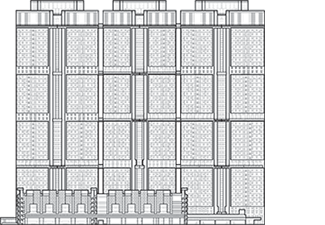Filter by
You must be a CTBUH Member to view this resource.

SkyVille @ Dawson
Building
Completed
2015
Residential
All-Concrete
BCA Green Mark Platinum
148 m / 485 ft
47
1
960
527
13
3 m/s
111,106 m² / 1,195,935 ft²
You must be a CTBUH Member to view this resource.
You must be a CTBUH Member to view this resource.
Proposed
Construction Start
Completed
Usually involved in the front end design, with a "typical" condition being that of a leadership role through either Schematic Design or Design Development, and then a monitoring role through the CD and CA phases.
The Engineer of Record takes the balance of the engineering effort not executed by the “Design Engineer,” typically responsible for construction documents, conforming to local codes, etc.
Other Consultant refers to other organizations which provided significant consultation services for a building project (e.g. wind consultants, environmental consultants, fire and life safety consultants, etc).
You must be a CTBUH Member to view this resource.
Usually involved in the front end design, with a "typical" condition being that of a leadership role through either Schematic Design or Design Development, and then a monitoring role through the CD and CA phases.
The Engineer of Record takes the balance of the engineering effort not executed by the “Design Engineer,” typically responsible for construction documents, conforming to local codes, etc.
The Engineer of Record takes the balance of the engineering effort not executed by the “Design Engineer,” typically responsible for construction documents, conforming to local codes, etc.
The main contractor is the supervisory contractor of all construction work on a project, management of sub-contractors and vendors, etc. May be referred to as "Construction Manager," however, for consistency CTBUH uses the term "Main Contractor" exclusively.
Other Consultant refers to other organizations which provided significant consultation services for a building project (e.g. wind consultants, environmental consultants, fire and life safety consultants, etc).
2016 CTBUH Awards
2016 CTBUH Awards
28 August 2017 - CTBUH News
22 June 2016 - Awards

17 October 2016 | Singapore
This presentation proposes an alternative to the continuing implementation of unsustainable 20th century urban planning models. By using WOHA’s mini-city projects and proposals as prototypes...

01 July 2018
Swinal Samant & Srilakshmi Menon, National University of Singapore
By the year 2050, the world population is set to increase to 9 billion people, of which 66% will be living in cities. It is...

17 October 2016 | Singapore
This presentation proposes an alternative to the continuing implementation of unsustainable 20th century urban planning models. By using WOHA’s mini-city projects and proposals as prototypes...

18 September 2014 | Singapore
Asia’s rapidly growing metropolises demand an alternative strategy for city planning and architecture that addresses the need to live appropriately and sustainability with our tropical...

01 July 2018
Swinal Samant & Srilakshmi Menon, National University of Singapore
By the year 2050, the world population is set to increase to 9 billion people, of which 66% will be living in cities. It is...

08 August 2017
Swinal Samant & Na Hsi-En, National University of Singapore
This paper examines the effectiveness of the design strategies used in two HDB developments for encouraging active usage and social interaction. The study was conducted...

17 October 2016
Elena Generalova, Viktor Generalov & Natalia Potienko, Samara State University of Architecture and Civil Engineering
Rapid urbanization causes major problems of urban sprawl and social stratification, and at the same time it opens up new opportunities of shaping dense vertical...

17 October 2016
Mun Summ Wong, Richard Hassell & Alina Yeo, WOHA Architects
The 20th-century city developed in response to industrialization and population growth, with a planning vision encoded in regulations that limited evolving with the times. The...

17 October 2016
Mun Summ Wong, Richard Hassell & Alina Yeo, WOHA Architects
This paper proposes an alternative to the continuing implementation of unsustainable 20th century urban planning models. By using WOHA’s mini-city projects and proposals as prototypes...

16 September 2014
Mun Summ Wong, Richard Hassell & Alina Yeo, WOHA Architects
Asia’s rapidly growing metropolises demand an alternative strategy for city planning and architecture that addresses the need to live appropriately and sustainably with our tropical...

01 August 2009
Mun Summ Wong & Richard Hassell, WOHA
High-rise, high-density living has been embraced as a positive accommodation solution for many millions of people living in Asia's growing urban metropolis. This paper outlines...
28 August 2017
CTBUH is launching a new academic initiative, empowering Master's-level architecture students to research new possibilities in rope-less elevator technology.
22 June 2016
CTBUH is proud to announce the winners and finalists for the CTBUH 2016 Tall Building Awards, chosen from a pool of 132 submissions vying for recognition.
Subscribe below to receive periodic updates from CTBUH on the latest Tall Building and Urban news and CTBUH initiatives, including our monthly newsletter. Fields with a red asterisk (*) next to them are required.
View our privacy policy